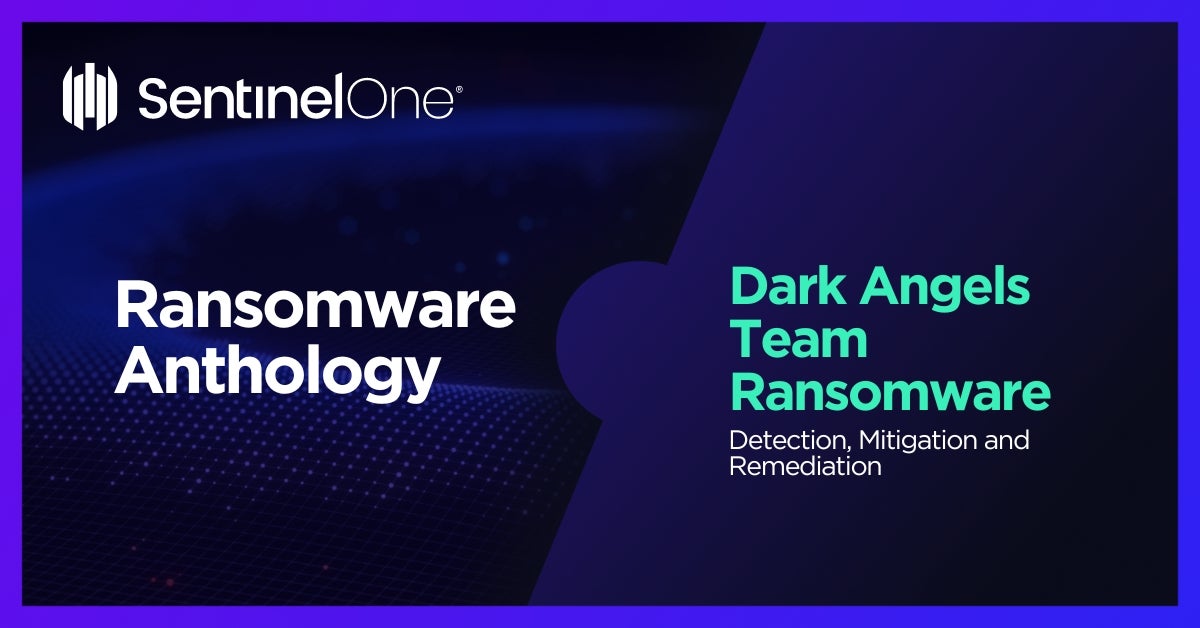Dark Angels Team Ransomware: In-Depth Analysis, Detection, and Mitigation
Dark Angels Team emerged in May 2022. Actors behind Dark Angels Team campaigns practice double extortion – demanding payment for a decryptor, as well as for the non-release of stolen data. The code for Dark Angels Team’s Windows-focused payloads is derived from the leaked Babuk builders and is nearly identical feature-wise. In late 2023, Linux/ESXi-focused payloads were discovered. These non-Windows variants of Dark Angels Team ransomware are not derived from Babuk, instead opting for a more bespoke codebase akin to RagnarLocker.

What Does Dark Angels Team Ransomware Target?
Dark Angels Team ransomware has been found to target a variety of industries including healthcare, government, finance, and education. In September 2023, automation and manufacturing company Johnson Controls was targeted in a ransomware attack where threat actors used DarkAngels ransomware to lock the company’s VMWare ESXi servers.

How Does Dark Angels Team Ransomware Work?
Dark Angel Team’s Windows payloads are based on the source code of Babuk, and function in very much the same way. The ransomware will attempt to inhibit system recovery and terminate any process that may interfere with the encryption process.
Linux/ESXi-focused payloads from Dark Angels Team are based on a different codebase, and therefore differ greatly from their Windows counterparts. Dark Angels Team payloads on Linux/ESXi are 64-bit Executable & Linkable Format (ELF) binaries designed for Intel-based Linux systems. On execution, the program logs the encryption progress to the hardcoded log file name, wrkman.log, which is saved to the directory that the DarkAngels binary is run from. DarkAngels (Linux) uses AES with a 256-bit key to encrypt files.
Dark Angels Team (Linux) takes optional arguments, which are documented internally as dl:m:s:v.
| Argument | Function |
| -m | Allows the operator specify how many encryption threads to run concurrently, which can be 10, 20, 25, 33, or 50 |
| -v | Enables verbose logging mode to the command line |
| -l | Allows the operator to specify a log file name for the progress log |
Dark Angel Team Ransomware (on Windows) will accept either the ‘paths’ or ‘shares’ arguments to enable network discovery and enumeration. Different methods and APIs are used depending on which argument is passed to the ransomware payload executable.
Dark Angel Team attacks are very specific, with target names appearing in the samples and related ransom notes. In the Windows version, the ransomware has the ability to spread to adjacent hosts. When spreading over the network, the payload processes each machine in serial, one after the other, making the encryption process across the network less efficient and more time consuming.
How to Detect Dark Angels Team Ransomware
The SentinelOne Singularity XDR Platform can identify and stop any malicious activities and items related to Dark Angels Team ransomware.
In case you do not have SentinelOne deployed, detecting Dark Angels Team ransomware requires a combination of technical and operational measures designed to identify and flag suspicious activity on the network. This allows the organization to take appropriate action, and to prevent or mitigate the impact of the ransomware attack.
To detect Dark Angels Team ransomware without SentinelOne deployed, it is important to take a multi-layered approach, which includes the following steps:
- Use anti-malware software or other security tools capable of detecting and blocking known ransomware variants. These tools may use signatures, heuristics, or machine learning algorithms, to identify and block suspicious files or activities.
- Monitor network traffic and look for indicators of compromise, such as unusual network traffic patterns or communication with known command-and-control servers.
- Conduct regular security audits and assessments to identify network and system vulnerabilities and ensure that all security controls are in place and functioning properly.
- Educate and train employees on cybersecurity best practices, including identifying and reporting suspicious emails or other threats.
- Implement a robust backup and recovery plan to ensure that the organization has a copy of its data and can restore it in case of an attack.
How to Mitigate Dark Angels Team Ransomware
The SentinelOne Singularity XDR Platform can return systems to their original state using either the Quarantine or Repair.
In case you do not have SentinelOne deployed, there are several steps that organizations can take to mitigate the risk of Dark Angels Team ransomware attacks:
- Educate employees: Employees should be educated on the risks of ransomware, and on how to identify and avoid phishing emails, malicious attachments, and other threats. They should be encouraged to report suspicious emails or attachments, and to avoid opening them, or clicking on links or buttons in them.
- Implement strong passwords: Organizations should implement strong, unique passwords for all user accounts, and should regularly update and rotate these passwords. Passwords should be at least 8 characters long, and should include a combination of uppercase and lowercase letters, numbers, and special characters.
- Enable multi-factor authentication: Organizations should enable multi-factor authentication (MFA) for all user accounts, to provide an additional layer of security. This can be done through the use of mobile apps, such as Google Authenticator or Microsoft Authenticator, or through the use of physical tokens or smart cards.
- Update and patch systems: Organizations should regularly update and patch their systems, to fix any known vulnerabilities, and to prevent attackers from exploiting them. This includes updating the operating system, applications, and firmware on all devices, as well as disabling any unnecessary or unused services or protocols.
- Implement backup and disaster recovery: Organizations should implement regular backup and disaster recovery (BDR) processes, to ensure that they can recover from ransomware attacks, or other disasters. This includes creating regular backups of all data and systems, and storing these backups in a secure, offsite location. The backups should be tested regularly, to ensure that they are working, and that they can be restored quickly and easily.
Dark Angels Ransomware FAQs
What is Dark Angels ransomware?
Dark Angels is a ransomware variant that encrypts files and demands cryptocurrency payments. It was first observed in late 2023 targeting enterprise networks. After encryption, the ransomware drops a ransom note named README-DA.txt. Victims are directed to contact attackers via a Tor-based portal. You should note that Dark Angels uses double extortion, threatening to leak stolen data if ransoms aren’t paid.
What encryption algorithms are used by Dark Angels ransomware?
Dark Angels uses AES-256 for file encryption and RSA-2048 for encrypting the decryption key. They will embed the RSA public key directly into the ransomware binary. Your files remain locked until attackers provide the private key. These files cannot be decrypted without paying the ransom.
Does Dark Angels ransomware affect Windows and Linux systems?
Yes, Dark Angels targets both Windows and Linux systems. They will focus on Windows Server environments and Linux-based NAS devices. You should secure all endpoints, as the ransomware exploits vulnerabilities in both operating systems. Linux attacks are less common but occur in poorly configured networks.
Does Dark Angels use the Babuk source code?
Yes, Dark Angels incorporates modified Babuk ransomware code. They will customise the encryption routines to avoid detection. You should look for similarities in ransom notes and TTPs. The codebase is altered to turn off security services more aggressively than standard Babuk variants.
What techniques does Dark Angels use for lateral movement?
Dark Angels uses PsExec and WMI to spread across Windows domains. They steal credentials using Mimikatz-style tools. Your network shares and administrative accounts are primary targets. The ransomware also abuses legitimate remote management tools like AnyDesk for persistence.
Does Dark Angels attempt to turn off backup or security services?
Yes, Dark Angels terminates processes related to backups and antivirus software. They execute commands to delete Volume Shadow Copies. If your backup servers are connected to the network, they may be encrypted. The ransomware also disables Windows Defender and firewall services.
What are the indicators of compromise (IOCs) for Dark Angels ransomware?
IOCs include files with the .darkangels extension and ransom notes named README-DA.txt. They will create registry entries under HKEY_LOCAL_MACHINE\Software\DarkAngels. You should monitor for sudden spikes in CPU usage and suspicious PowerShell executions. Network traffic to Tor exit nodes is another red flag.
How can organisations detect a Dark Angel ransomware infection?
You can detect Dark Angels by monitoring for mass file renames. There are alerts for vssadmin.exe deleting shadow copies. They will leave event logs showing disabled security services. You can use EDR tools like SentinelOne to flag unauthorised remote desktop protocol (RDP) connections.
What preventive security measures help defend against Dark Angels ransomware?
You should enforce multi-factor authentication for all remote access. Patch VPNs and RDP services immediately. There are email filtering solutions that block malicious attachments and segment networks to limit lateral movement. Regular offline backups are a good defense against encryption attacks.
What steps should be taken immediately after a Dark Angels ransomware attack?
Disconnect infected devices from the network—contact incident response professionals. If you have offline backups, prepare to restore data. Do not delete ransom notes or encrypted files. Go and report the attack to law enforcement and cybersecurity agencies immediately.